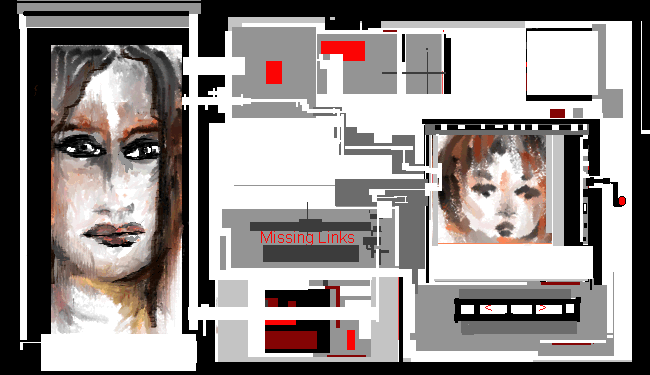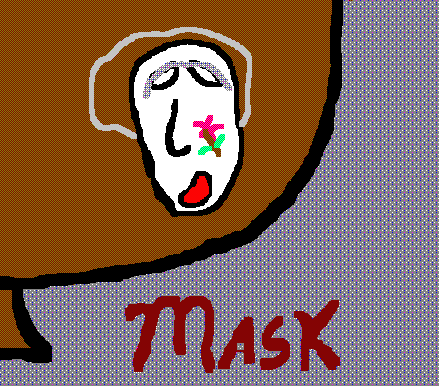Dowry Death

Dowry Death Beat: Live-Time-Emit-Evil by Anuppa Caleekal, PC Paintbrush, Mouse © Copyright 1996
DOWRY DEATH
ITS GRUESOME REALITY AND FUTURE INTERFACE IN A DIGITAL CULTURAL REVOLUTION
by Anuppa Caleekal Copyright © 1997
No image, text, or part of, may be duplicated without written permission
The need for the enactment of the 1961 Dowry Prohibition Act in India's Penal Code stemmed from a noticeable increase in the number of Indian brides documented to have died early in their married years from suspicious, and mysterious circumstances. The cause of death was characteristically labeled as "kitchen fires". The rampant occurrence of bridal deaths by these so called kitchen fires were usually uniform in nature with the classical setting of the young bride found dead in the kitchen, clad in a kerosene soaked sari, trapped in flames and left alone to burn to ashes. The guilty party? Very often it was the groom's mother or someone from the groom's family. In some cases, the groom did the act himself. The reward? Another bride, another dowry.
Along with curious vicissitudes of a modernizing India, the growing middle class with its opportunities for upward mobility also propagated inevitable inflationary monetary expectations to an already existing union of marriage and money. This comradeship between money and marriage may be considered as one of the most promiscuous and prevalent linkages pertaining to the past and present of many cultures.
The term, "dowry" as a quantifiable offering in a marriage does not have its roots pertaining solely to the Indian culture. It has been noted to be part of the customs practiced in early 12th century Europe and was often reflected in European fairy tales and literature making such references to a woman's "dowry" as offerings of a "straw mattress", a "wooden stool" or "farm animals". The exchange and amount of "money" for a dowry depended on the relative status of being a rich or poor woman. Monetary exchanges also had the function of preserving the aristocracy as a class and having marriages arranged as a means of cultural and economic determination. An interesting utilization of dowry, symbolizing both marriage as well as an union of aristocracy and colonial dominance was in 1662 when Charles 11 of England was given the Indian city of Bombay as a dowry for marrying Catherine of Braganza of Portugal. At that time the Portuguese owned Bombay.
It is ironic that in India dowry was originally designed to safeguard the woman and it was the provision of " Sthreedhan" ("Sthree" meaning woman and "dhan" wealth) in the form of money, property or gifts given solely to the woman by her parents at the time of her marriage. "Sthreedhan", an inheritance was meant to exclusively belong to the woman at the time of her marriage. The abuse of this custom eroded and aborted the original meaningful function of dowry as a safety net for the woman and was corrupted to become the price tag for the groom and consequently the noose for the bride. The price of the Indian groom astronomically increased and was based on his qualifications, profession and income. Doctors, Chartered Accountants and Engineers even prior to graduation develop the divine right to expect a "fat" dowry as they become the most sought after cream of the graduating and educated dowry league. A reactionary preliminary wave of preserving oppressive practices of dowry demands, harassment and placing Indian males as high commodity line of goods, appeared to surface also in the West and other countries where immigrants of Indian origin established themselves.
The steady rise of the gruesome scenario of dowry deaths in India brought with it a sense of hopelessness in light of the lack of legal provisions and avenues made available to families who lost their daughters in the expansive and intricate dowry wedding web. In 1961 with the Dowry Prohibition Act, dowry was officially outlawed but in reality eradication was far from accomplished. In 1986 harsher legal amendments to the 1961 Dowry Act such as Section 174 CrPC enforced investigations of suspicious bridal deaths and punishment of seven years to life in imprisonment and possibly death for those found guilty and convicted of bride burning. In spite of these legal breakthroughs, shocking statistics on dowry deaths continued to show up in Indian newspapers. The 90's showed a steady yearly increase in bridal death tolls with many more deaths unreported. Like clockwork every 12 hours a dowry related death claimed to have taken the lives of over 20,000 women across India between 1990 and 1993. And the dowry death statistical beat goes on…live, time, emit, evil…
In India not only was there an apparent increase of dowry-related deaths from kitchen fires but from this weed other covert forms of related oppression sprouted. Some of these led to psychological torture, suicides and murder of married women, desertion by their husbands, rampant abortion of female fetuses, and poor families resorting to female infanticide for fear of not being able to provide dowry.
In 1995 there was much media exposure about the Ambati family and the legal encounter with India's Dowry Act. The Ambatis, resided in the United States and were U.S. citizens of Indian origin. The Ambati family a prominent, educated family was also famous in that the groom's brother at 17 became the world's youngest graduate and doctor. The family was very involved and known for their commitment to social and community service and educational pursuits through their establishment of a charitable educational foundation.
In the June of 1995 the Ambati groom, a young doctor, married his bride in India. The bride accompanied the groom back to the U.S but the marriage was short lived and the bride returned to India. Months later when the Ambati family visited India to receive a prestigious and well publicized award from the Raja Lakshmi Foundation, the bride filed a claim with allegations of dowry harassment against the Ambati groom, and his family. Indian authorities arrested the Ambati family the instant they revisited India. For almost 4 years the Ambatis battled the courts of India. In a recent update which appeared in The India Monitor (Jan 9 - Jan 16, 2000 issue Vol.X, No.464, p.16) it was announced that the Ambati family "has now been acquitted of all charges" and that, " Kolar Gold fields sessions judge K.S. Venkoba Rao pronounced the order of acquittal on April 28, 1999."
The article also stated, that, "during the course of the trial the Ambatis produced a tape " in which the bride's father " demanded US $500,000 to drop all the charges". Very soon thereafter the bride " wrote to the Ministers for Home Affairs and Law & Parliamentary Affairs that she was " unconditionally withdrawing" all charges against the Ambati family".
The significance of the Ambati case and its recent legal outcome illustrates two things. One being the emergence and surfacing of dowry related problems entering the domain of family law and matrimonial life on foreign soils, stretching far beyond India's cultural and social perimeter. More importantly it also depicts the possibility of the Dowry Prohibition Act being abused.
Inspite of the Indian government banning practices of dowry harassment, extortion and demands through its provisions of the Dowry Prohibition Act, as a preventive means to abolish dowry deaths, the social evil of dowry deaths continues. The recent update and legal outcome of the Ambati case illustrates the other side of The Dowry Prohibition Act, the possible abuse of it. The legal system has the task of weeding out legitimate allegations from those that appear to abuse the law by filing false dowry claims as a possible counter mechanism to blackmail and extortion via matrimony. There is a growing number of "passport weddings" where Indians living in India seek matrimony with non resident Indians(NRI) holding American and Canadian citizenships. Once they get their foreign passports, arrive on the desired foreign soil , many of these "con artists" resort to tactics that extract more "dollars" from the (NRI) family they married into with the males trying to extract more dowry and the females crying false allegations of dowry harassment. When the mentality of dowry demands, along with accusations of extortion and harassment whether true or false start to be part of the imported and migrating baggage, it marks a nouveau scenario among some immigrant marital problems and family law cases. The autopsy of some arranged marriages which extended beyond Indian soil and resulted in separation and breakdown started to reveal traces of carrying the burden of this imported baggage as the norm for negotiating marriages and staying "happily" married.
Social laws are required where culture has failed to institutionally stop injustices of dowry deaths, the killing and abandoning of female infants, the banishment of women who fail to produce sons and family breakdown due to dowry harassment. More importantly there needs to be a cultural rethinking on the status of women which can occur only through education. The problem is compounded by the fact that 63 percent of the female population in India is illiterate. Perhaps a good starting point is population control and compulsory education for boys and girls alike.
The Future of Dowry Death in the Era of the Digital Cultural Revolution
The continuance of internal contradictions calmly coexisting with the cultural ethics of dowry, arranged marriages and the rights of young girls and women remains a challenge. Ultimately social responsibility will rest upon the initiative and mentality of that segment of the Indian male population having a belief system entrapped in the extortion of dowry. This particular male group mentality has no other choice but to accommodate to the outcome of these practices being eradicated or fight to withstand societal pressure in the era of Digitalism* . It is inevitable that the stamina and resistance of this strain of population has no prospect for longevity as a homogenous group simply by the nature of the evolving world no longer being a simplistic dichotomy of black and white. Sexual differentiation itself is challenged by sexual preferences. The era of Digitalism* allows the constant movement and fusion of various fields, visions and interest groups crossing paths placing the big bang upon rigidity and stagnation and opening a totally nouveau form of literacy determined by technological advantage.
The demands of any rapidly modernizing country dictates the need to grasp the random selection of cultural values thrust by the need to evolve, adapt, survive, and be aggressive enough to want and have all "the right stuff" in the shortest span of time and space. However along with these demands so also is cast the enigmatic task of balancing acts of good and evil. The quest and random selection of the "right stuff" of tools, skills, intelligence and emotion marks the evolutionary drama of mankind's ultimate production … human culture.
Today as we live within the universal framework of the Digital Cultural Revolution, social crimes such as dowry deaths are no longer allowed to exist in isolation or overlooked for decades on end. Just as instant as the click of a mouse so can emotions of shame and disgrace be instantly transmitted, breaking the dowry death beat of live, time and emit evil. The ultimate potential to maximize change in the era of Digitalism * will lie in the hands of those with the best digital tools and with those who invent future tools. The ethics of change again is a balancing act of good and evil, or in terms of the era of Digitalism* it will be determined by the use and misuse of bytes and brains. In many ways the Internet is a most powerful Diva, a world wide network communicator singing out to Homo sapiens digitus eventually providing each digital citizen with the opportunity to know, vote and participate. This digital connection makes paths go beyond the geographical barriers and walls of every citizen's culture and nationality enabling each to engage in a network of virtual united nations.
A digital connection is the most technologically advanced participatory grassroots form of democracy allowing one to create his or her own chat channel, ICQ messages, form groups based on common interests or tell and document history to the world. A digital connection crosses geographical, cultural and political barriers enabling faster and continuous development of new world legal and ethical value systems determined by techno-economic functional investments, techno-literacy needs and feedback systems. This ultimately increases the challenge for Homo sapiens digitus to balance acts of good and evil, deal with constant change, scan evidence and face opposition literally with the wealth in bytes and brains.
It allows the isolated or the silent majority and all digital citizens to be connected not to a finite destination but an infinite path of links making the six o'clock news never the same again. It allows connecting to others globally on newsgroups, e-mail a petition, and formulate a www virtual committee or task force more spontaneous, instantaneous, multi-disciplinarian and multi-functional than ever before in the history of technology. A digital connection allows developing a worldwide registry for purposes of consulting, advocacy and recruitment of productive human resources with multi-media and multi-tasking processes. A Digital Connection is the first phase in the Digital Cultural Revolution.
Second Action. Third Change. The Outcome = Digitalism*
* DIGITALISM*
What mankind does with the advancement of his intellectual creativity and the innovation of ever more miraculous technologically evolving computer tools has set the stage for its outcome. Digitalism ... a form of artistic expression ... aWindows 95 political economy ... an experience of thought and culture in a compact disc. Something more than an overpowering ideological chip … it is an evolutionary stage of Homo sapiens. Never has man experienced such a revolutionary form of individualism so dynamic. A Stairway to Heaven with social and cultural exchange ... an instantaneous cybernetic feedback system ... freedom and access to knowledge so widespread and potentially equalized eroding all forms of petty parochialism. The end of the tunnel opens into a new world view and the procreation of a nouveau genetic and evolutionary form of the human brain with virtual sprouting chains of artificial digital DNA and the birth of Homo sapiens digitus.
© www.digitalism.org
Art.doc DOWRY DEATH
BY
ANUPPA CALEEKAL
Art: >>> LIVE, TIME, EMIT, EVIL <<< Anuppa Caleekal, © Copyright 1995
Doc: DOWRY DEATH, ITS GRUESOME REALITY AND FUTURE INTERFACE IN A DIGITAL CULTURAL REVOLUTION.
Copyright © Anuppa Caleekal
No image, text, or part of, may be duplicated without written permission.
If you would like to comment, provide information about ongoing research, upcoming conferences, news, events, links, books, films, or experiences related to dowry death...
Email to: anuppa@hotmail.com



